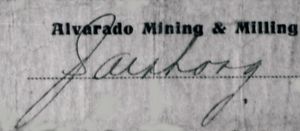The vales issued in Hidalgo del Parral
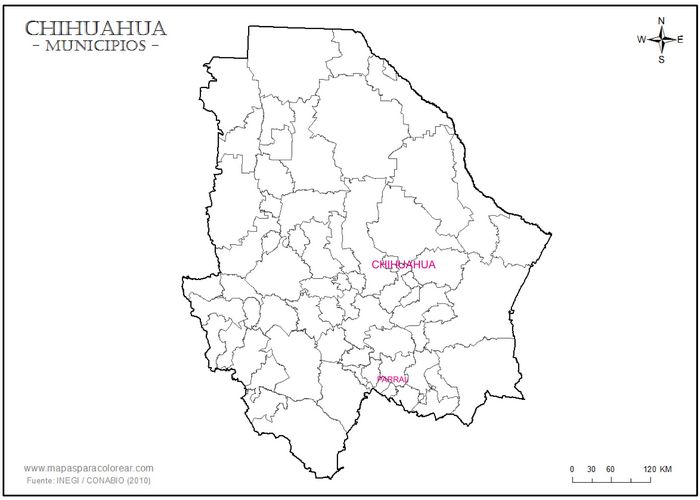
In the middle of 1913, because of the disruption in communications and the scacity of small change, certain companies in Parral and the surrounding area began to issue their own fractional paper currency. These valores de trabajo were payable to the bearer on presentation in the company's offices as soon as communications were restored (al portador una vez que se reanuden las comunicaciones, en sus oficinas de esta ciudad, á la presentación de esto).
Many businesses and individuals were unwilling to accept some of these vales, and General Manuel Chao issued a circular[text needed] calling upon the issuers to formally request permission and to offer adequate guarantees. In consequence, on 22 September 1913 Chao issued a decree that people should accept the notes of the Compañía Ferrocarril Parral y Durango; the Alvarado Mining and Milling Company; the San Francisco del Oro Mining Company; the Concurso Mexico Consolidated Mining and Smelting Company; San Pedro, Guanaceví and E. T. (sic) Notts, Guanaceví, and not accept the Fundicion de Fierro y Bronce, the El Rayo Mining and Development Company, the Mina La Cumbre y La Bufa or any other company that was not on the list of acceptable notesAMP, Tesorería, Tesorería, Correspondencia, caja 164, exp. 1.
Later on, the Minas Tecolotes y Anexas; Veta Colorada y Anexas; Mina Veta Grande y Anexas and the Cia Agricola y de Fuerzas Electrica del Rio de Conchos were added to the listAMP, Guerra, Comandancia Militar, Correspondencia, caja 2, exp. 6, and on 27 September, after giving adequate guarantees, the Minas La Cumbre y La Bufa were authorised to issue notes that would be of forced circulationAMP, Gobierno, Jefatura Política y Presidencia Municipal, Correspondencia, caja 68, exp. 2.
On 5 October Villa, while at Torreón, decreed that the notes issued by the various companies in Chihuahua and Durango should be accepted as legal tender until such time as they were redeemed. He, for his part, would ensure that the companies honoured their paper¡Patria Libre!, Durango, 10 October 1913. In a decree of 15 December 1913 the commander in Durango, Coronel E. R. Nójera, listed the bonos of Parral amongst the revolutionary issues that were of forced circulation in that state ¡Patria Libre!, Durango, 23 December 1913.
Once the Chihuahuan rebels issued their own currency, they quickly moved to stamp out other issues. On 23 December 1913 Villa ordered that the vales issued by certain Mexican and foreign-owned businesses (casas comerciales mexicanas y extranjeras) since the beginning of the revolution should be exchanged for revolutionary paper currency. However, in Parral they did not have the new currency and on 29 December General Luis Herrera, the Jefe de Armas issued a circular that the vales should continue to be accepted. Local businesses were less willing and on 31 December formed themselves into a “Unión Mercantil” that demanded that the issuers give adequate guarantees to business and the public in generalAMP, Gobierno, Jefatura Política y Presidencia Municipal, Libros minutarios, 1913, AL12-13-000-102 letter to Presidente Municipal, 10 January 1913.
On 6 January 1914 the Presidente Municipal received copies of the notice that only sábanas and Constitucionalist issues were of forced circulationAMP, Gobierno, Jefatura Política y Presidencia Municipal, Libros minutarios, 1913, AL12-13-000-102 and on 12 January the Secretario de Gobierno told him to make sure that these companies did not issue any more vales. He therefore wrote to the various companies and to the printers in the city informing them of the edictibid..
On 23 January Governor Chao set a deadline of 31 January for exchanging these irregular issues, though on 31 January the government extended the deadline: 5 February within the city of Chihuahua and 10 February outsidePeriódico Oficial, 1 February 1914. The notice refers specifically to mining scrip (vales de compañías mineras). Thereafter anyone in possession of such notes would be deemed a counterfeiter. Chao made a similar pronouncement in ParralEl Paso Morning Times, 2 February 1914.
On 12 February Silvestre Terrazas wrote to Tomás Lizárraga D., the Administrador Principal del Timbre in Parral, thanking him for the details that he had sent about these vales. It was planned to exchange them for Chihuahua money, but they did not yet have enough notes. In the meantime Terrazas instructed the Presidente Municipal to acknowledge (haga efectivos) the vales he listed with the exception of banks that did not have any branches in the state and the Concurso México Consolidated Mining and Smelting Company, who had already agreed to back their notes with their bullionST papers.Part I, box 84. The same day the Secretario de Gobierno told the Presidente Municipal to ensure that the companies redeemed immediately, in silver or on cheques drawn on a Chihuahua or foreign bankAMP, Gobierno, Jefatura Política y Presidencia Municipal, Libros minutarios, 1913, AL12-13-000-102. Presumably paying the Tesorería rather than individual holders..
Thus, the vales were gradually redeemed, although it took some time because of a delay in receiving sufficient of the new sábanas with which to replace them. It was also not without difficulties: when the Tesorero Municipal heard that the Recaudación de Rentas had received funds to make the exchange, it sent over $1,000 in vales, but the Recaudación only accepted $500, claiming that the rest were too well used, and the Administración del Timbre refused to accept other vales with which the Tesorería tried to pay its taxesAMP, Gobierno, Jefatura Política y Presidencia Municipal, Correspondencia, caja 69, exp 1 report of Tesorero Municipal, 18 February 1914. On 5 March the “Unión Mercantil” was still complainingAMP, Gobierno, Jefatura Política y Presidencia Municipal, Correspondencia, caja 69, exp 1.
However, it is obvious that as well as the issues during Chao’s time some companies made further issues at later dates when the shortage (or unacceptabilty) of other money demanded it. Thus, the Alvarado Mining and Milling Company and the Minas Tecolotes y Anexas were paying their workers with some sort of scrip in the first half of 1916.
On 16 December 1917 the Presidente Municipal of Parral and a special commission met with the representatives of various companies to try to resolve outstanding issues but they could discover few hard facts. Most of the companies’ representatives could claim that they were not around at the relevant time and unfortunately (or conveniently) most records had been destroyedAMP, Gobierno, Jefatura Política y Presidencia Municipal, Actas, caja 23, exp 19.
The companies or individuals who issued vales were:
The Alvarado Mining & Milling Company
The large Alvarado Mining and Milling Company operated the mine at La Palmilla, just outside Parral. In 1907 the wealthiest man in Mexico was Pedro Alvarado, a poor labourer who made an immense fortune within a few years from this mine. As a patronising and racist American newspaper article reported: “Once a poor miner, almost on the verge of beggary, he was, through many tribulations, animated by a faith in providence and in his mine in the side of an unknown hill near Parral. How he dug there, hiring labor when he could, and working alone when he could not, and how at last, within the life span of the youngest child who could read these lines, he struck the great bonanza which has made him one of the wealthiest men In the southern republic, make a story of thrilling interest. Alvarado is ignorant and narrow, a man in whose hands wealth is but a toy. Yet he has accepted that toy with a religious conviction that It is in the nature of a trust. As coming from Mexico’s soil, he has said that it belongs to Mexico, and a stancher patriot or a patriot who showed more by his works, never lived. It Is said that he has offered to pay the national debt of his country. He is a home-trader, however, and buys his goods of local merchants, giving preference to home products. He Is a generous philanthropist, and distributes alms among the poor with a lavish hand. Pedro Alvarado lives in a palace of many rooms, fitted in magnificent taste. Yet that palace is oppressive to him - just why, he does not understand - and his favorite room is the wine cellar half under ground. Not that he is too fond of its contents, but because he finds In the rough simplicity of the cellar the relief which he craves. There, a few weeks ago, the writer talked with him, as the millionaire sat on a case of imported champagne, drinking Mexican beer. He Is a man of small stature, judged by American standards, yet having considerable native dignity and poise. He is but 36 years old, and looks no more. A slight black mustache and beard, and ill-fitting black broadcloth suit, a made-up black satin cravat, in which glistens an immense diamond pin, which shines no more than his little black eyes, describe the man. Alvarado’s wealth is estimated by generous correspondents at $150,000,000. He is probably worth one third as much, and holds sole title to a mine which is now producing about $1,500,000 net profit each year, but which, under progressive management, no doubt could give double, or even three times, that amount"Sacramento Daily Union, Vol. 112, No. 165, 5 February 1907. It is not surprising that Alvarado was sympathetic to Francisco Villa.
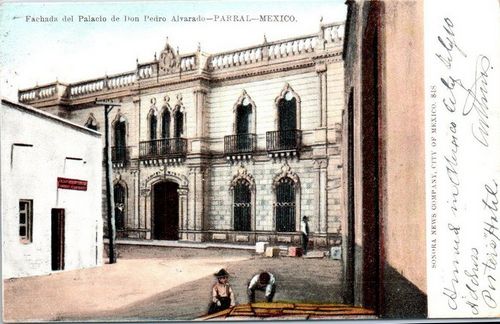
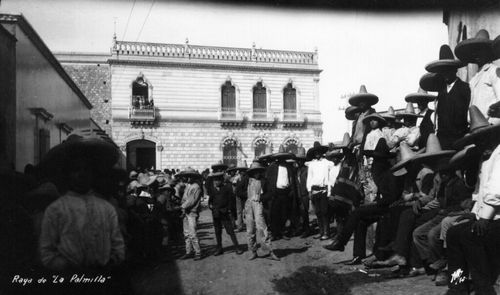
Payday at La Palmilla. The large house in the background is the Palacio Alvarado
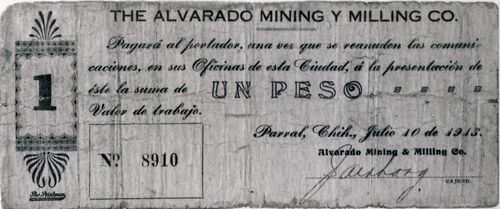
| date on note | from | to | total number |
total value |
||
| 50c | ||||||
| $1 | [ ] April 1913 | |||||
| [ ] May 1913 | ||||||
| 10 July 1913 | includes number 8910 | |||||
| [ ] August 1914 | ||||||
| [ ] September 1914 | ||||||
| [ ] October 1914 | ||||||
| [ ] November 1914 | ||||||
| $10 | 19 May 1913 | see comment below |
The Alvarado Mining and Milling Company must have issued at least three different denominations in 1913, viz. 50c[image needed], $1, and $10[image needed] though only the $1 note is known. When Lorenzo Frauco was arrested in Parral in December 1913 for counterfeiting he had in his possession $177.50 in notes of the company, hence the 50c; the $1 is known dated 10 July 1913; and a forged $10 note, numbered 15246 and dated 19 May 1913, was an exhibit in another trialUnless the $10 note was an altered $1 note. AMP, [ ].
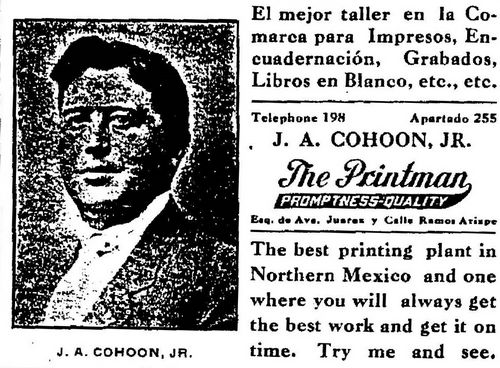
The notes were printed by The Printman, a printing press in Parral owned by A. L. Cohoon (sic), that also produced the Parral Miner.
They were guaranteed by J. McQuatters, a major shareholder, with the security being lodged in an El Paso bank, and signed by a Long as cajero. At the time the general manager was a James I. Long and the accountants (contadores) Johnson and LongAMP, Gobierno, Jefatura Política y Presidencia Municipal, Actas, caja 23, exp 19.
These notes were redeemed in sábanas.
In June 1916 the Presidente Municipal Interino of Parral, José de la Luz Herrera, reported to Chihuahua that the Alvarado, without oficial authorisation, was again paying with vales[image needed], that had a guaranteed value of 25c oro americano, and that this was having a depreciating effect on the recently introduced infalsificablesAMP, Gobieno, Jefatura Política y Presidencia Municipal, Libros Minutarios, AL12-13-000-103. On 22 July 1916, probably on the prompting of the Chihuahua government, de la Luz Herrera wrote to Carranza urgently asking whether the company could continue paying in these valesAMP, Gobieno, Jefatura Política y Presidencia Municipal, Libros Minutarios, AL12-13-000-111. Given that Carranza was a stickler for constitutionalilty, he will almost certainly have refused, but the company soon after suspended operations when General Jacinto B. Treviño prohibited the export of silver.
The company’s local records were destroyed when Villa seized them in November 1916.
On 13 March 1918 the Oficial Mayor in Chihuahua, J. A, Enríquez, issued a notice to the holders of the vales al portador issued by the Alvarado Mining and Milling Company in 1913 and 1914Periódico Oficial, 23 March 1918 that they had six months in which to redeem them. The notice set the various rates of exchange for the different issues, based on the official index of inflationat par oro nacional for the notes issued in April and May 1913; 62c for July 1914; 53c August 1914; 40c September and October 1914, and 39c for November 1914. No mention is made of any 1916 vales, so they cannot have been a substantial issue.
La Fundicion de Fierro y Bronce de Parral
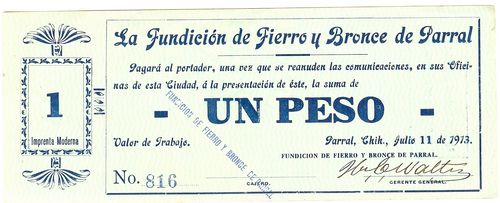
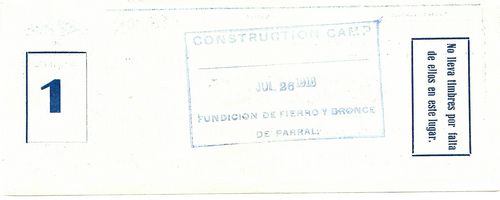
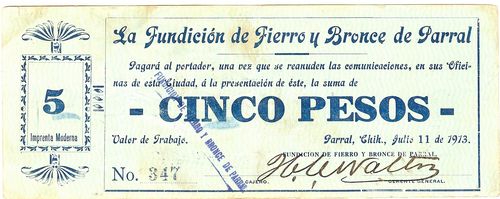
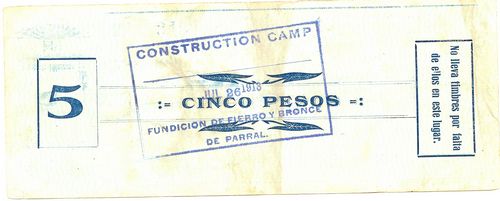
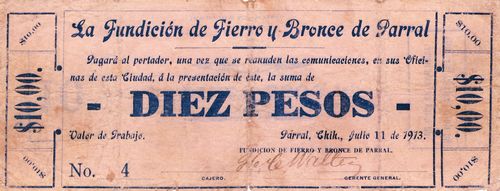
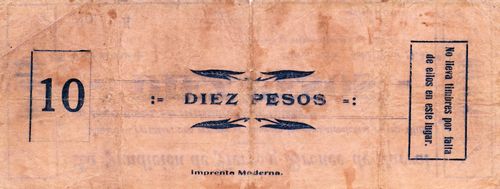
| from | to | total number |
total value |
||
| $1 | 1 | 999 | 999 | $999 | includes numbers 91 to 986CNBanxico #10108 |
| $5 | 1 | includes numbers 61 to 565 | |||
| $10 | 1 | includes numbers 4 to 100 | |||
La Fundicion de Fierro y Bronce de Parral issued valores, for one, five and ten pesos, dated 11 July 1913 and signed by H. C. Walters.
|
An H. C. Walters (sic) was reported running the Parral foundry in January 1912El Paso Herald, 27 January 1912 and an H. C. Walter (sic) was issued with the title to El Cometa Hailey mine in Minas Nuevas, Hidalgo del Parral in September of that yearBoletín Oficial de la Cámara Minera de México, 1 October 1912. On 2 January 1914 H. C. Walters (sic) “who said he owned several thousand acres in Chihuahua, including mining concessions” arrived in New Orleans on the steamer City of Mexico as a refugee from Veracruz. He said he was forced to pay the rebels $2,000 to get out of jail at Santa Rosalia (now Camargo). Americans in his section were disheartened, he said, because Carranza followers looted their ranchesAlbuquerque Morning Journal, 3 January 1914. |
 |
Examples of these notes were unknown until 1984 when a large group consisting of $1, $5 and a single $10 came onto the market, but we already knew of their existence because in a letter of 27 October 1913 to the Jefe de Armas in Parral Francisco Villa wrote
DIVISION OF THE NORTH
PERSONAL CORRESPONDENCE
COMMANDER IN CHIEF
Camargo, Chihuahua
October 27, 1913
Mister Chief of Arms,
Parral, Chih.,
Dear Friend:
Mrs. Manuela Ayala de Chacon, who lives in the city, has in her possession the sum of $1,000.00 (one thousand pesos) in paper money issued by the Iron and Bronze Company of Parral, Chihuahua, and signed by the General Manager of the same, Mister H. C. Walton, although the supreme reason of the interruption of communication lines has forced the company to issue the aforesaid documents and has further caused major problems to the poor people by leaving in their possession documents of this nature without any current value and therefore difficult to exchange into money.
In view of the foregoing, please declare that the aforesaid sum of one thousand pesos should be extended in a money order on a foreign exchange, the idea being that it must be in American currency without any discount, so that through the local mayor the bonds of the aforesaid Senora Chacon should be picked up and handed over to the Iron and Bronze Company.
Sincerely yours,
Francisco Villaletter by permission of Ing. Benjamine Herrera Vargas in Mexican Revolution Reporter, 15, November 1979.
Compañía del Ferrocarril Parral y Durango (Parral and Durango Rail Road Company)
The Parral and Durango Rail Road Company made an issue[image needed] in 1913 to pay its workers because of the shortage of banknotes, though its representative thought that the total amount was very insignificant, and might have made another issue in 1916. The notes were signed either by Robert J. Long, the general manager, or by J. Reno Wilson. Unfortunately, the company’s records were reduced to ashes in one of the Villista raidsAMP, Gobierno, Jefatura Política y Presidencia Municipal, Actas, caja 23, exp 19 evidence of Manual Cortés.
| Robert J. Long was the brother of James I. Long and assistant manager of the Hidalgo Mining Company. He was appointed assistant manager of the Parral and Durango Rail Road Company in August 1906The Mexican Herald, 13 August 1906 and succeeded his brother as general manager on 14 November 1909The Mexican Herald, 15 November 1909. | |
| J. Reno Wilson |
Minas Tecolotes y Anexas
Santa Bárbara is a historic mining town about twenty-five kilometres south-west of Parral.
The Minas Tecolotes y Anexas in Santa Bárbara were part of the American Smelting and Refining Company (ASARCO). In March 1913 General Manuel Chao had approached the managers there, demanding $5,000 to pay for the “protection” provided by his troops. When the superintendent, W. P. Schumacher, refused the demand, Chao explained that without the money, he might not be able to prevent his own forces from raiding the mines. Schumacher reluctantly gave General Chao $2,750Washington National Records Center, Record Group 76, Mexican Claims Division, Awarded Claims, 1924-1938, box 221, docket 2312.
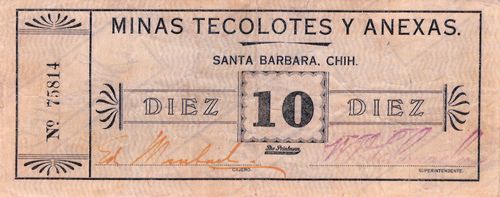
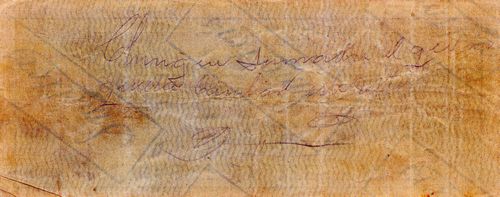
| from | to | total number |
total value |
||
| $10 | includes number 75814 |
The company issued a $10 note in 1913, also printed like other companies' valores by the Printsman press, with the inkstamped signature of the cashier (cajero) and superintendent (superintendente). These were issued later than the Parral notes because coinage continued to circulate longer in Santa Barbara and the company was able to pay in efectivo when in Parral they had already issued notesAMP, Gobierno, Jefatura Política y Presidencia Municipal, Actas, caja 23, exp 19. When the coinage dried up the local authorities and commerce suggested the vales, which represented money drawn on Mexico City or El PasoAMP, Gobierno, Jefatura Política y Presidencia Municipal, Correspondencia, caja 69, exp 1 letter of superintendent Gilbert, 21 February 1914: these were redeemed in legal tenderAMP, Gobierno, Jefatura Política y Presidencia Municipal, Actas, caja 23, exp 19.
| Ed Mau[ ][identification needed] |
 |
| W. P. Schumacher | 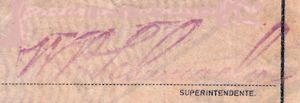 |
These $10 notes were counterfeited, as a Teódulo Talamantes had presented a false note in the company’s offices, and then asked the local authority to start an investigationibid..
On 21 February 1914 the company’s superintendent, L G. Gilbert, reported to the Presidente Municipal in Parral that the company had not been using their notes (contraseñas) for some time though it was difficult to redeem them because of the lack of sábanas and asked for permission to make payment in banknotes (billetes de Banco) for sums greater than five pesos, and in their own $1 notes for smaller amountsibid..
When the company renewed operations in 1915/1916, because the public was refusing to accept the legally-forced Carrancista currency, the company’s employees themselves asked to be paid with vales of 25 centavos oro (americano)[image needed]. These were later redeemed and by December 1917 only $126.75 was outstandingibid..
The Tecolotes mines are still being worked by Grupo México.
Veta Colorada y Anexas
The Veta Colorada mine was also in Santa Bárbara.
The El Rayo Mining and Development Company
The El Rayo Mining and Development Company was an American-owned mine in Santa Bárbara.
Señor Natividad Reyes
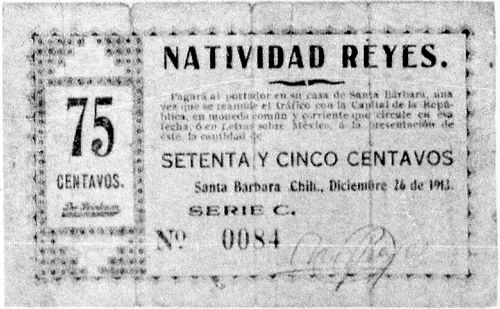
| series | from | to | total number |
total value |
||
| 75c | C | includes number 0084 |
Natividad Reyes, of Santa Bárbara, issued a 75 centavos valor, Series C, dated 26 December 1913 to be paid in his casa (commercial) once traffic with Mexico City had been renewed.
| Natividad Reyes | 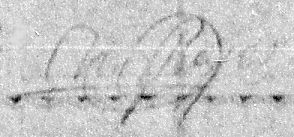 |
These notes were not included in Chao's decrees.
Veta Grande y Anexas
The Veta Grande y Anexas, at Minas Nuevas (now Villa Escobedo) was also part of the ASARCO group of companies (like Minas Tecolotes y Anexas) but issued its own vales.
Minas de la Cumbre y la Bufa
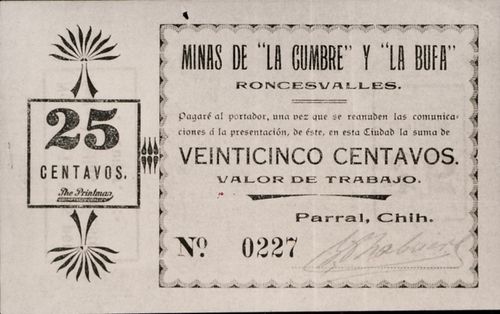
| from | to | total number |
total value |
||
| 25c | includes number 0227 | ||||
| $5,000.00 |
The Minas de la Cumbre y la Bufa were at Roncesvalles, ten kilometres south of Parral.
In 1913 Georges Chabriere, the mines’ engineer (ingeniero) issued $5,000 in vales. A valor for twenty-five centavos is known.
| Georges Chabriere |  |
By 27 September 1913 Eduardo Ricaud, representing the Casa Comercial “A. Ricaud y Cia.” had provided an adequate surety to the Cuartel General in Parral and the notes were declared of forced circulationAMP, Gobierno, Jefatura Política y Presidencia Municipal, Correspondencia, caja 68, exp. 2. A Ricaud y Cia ran the "Fabricas de Francia", situated in the Plaza Hidalgo, but on 28 February 1914 was forced to close down because of a shortage of stock.AMP, Tesorería, Tesorería, Correspondencia, caja 165, exp. 1. In November Alejandro Ricaud was kidnapped and murdered, even though his wife paid his ransom.
The San Francisco del Oro Mining of Mexico Limited
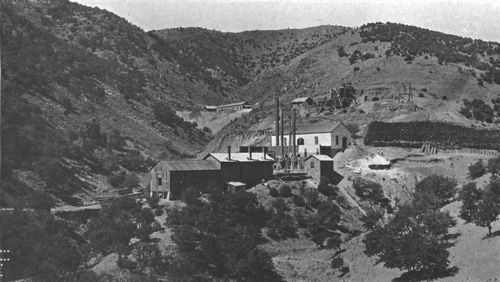
San Francisco del Oro is a beautiful mining town, about fifteen kilometres north of Santa Bárbara. The mine is still being worked and the ore is carried across the town to the crusher on an aerial tramway.
The San Francisco del Oro Mining Company Limited was an English company, with most of its properties within San Francisco del Oro.
Mina El Caballo
This company issued notes[images needed] in 1913 and redeemed them early in 1914.
On 11 February 1914 the manager of the El Caballo, Miguel Tinoco, was robbed in Jiménez and among other things the thief, José Barcenas, took a packet of cancelled notes. Barcenas was a linesman (celador de telegrafos) on the railways, working between Ortiz, Ciudad Chihuahua and Ciudad Juárez. He lent $80 (in sixteeen $5 notes) to Bernardino Galindo, who spent two in Parral. When these were shown to Tinoco to check if they were valid or not, Tinoco was able to identify the miscreants and Galindo was subsequently arrested in Santa Bárbara with the other $70. Senora Dolores Herrara, of Santa Bárbara, had also received a cancelled $5 from Felipe Camarillo, who was in charge of repairs to the railway (cabo de reparaciones de la via de los Ferrocarriles Nacionales). An order for Barcenas’s arrest was sent to Chihuahua on 18 FebruaryAMP, Gobierno, Jefatura Política y Presidencia Municipal, Libros minutarios, 1913, AL12-13-000-102 and passed on to the Inspector General de Policía on 22 FebruaryAlmada Collection, roll 810, 1472.
However, the company could also have issued notes in 1916 because in 1917 its representative, Isaac Zepeda, reported that notes were redeemed mostly in gold, silver or in dollars at a rate of two for one, and very few notes were outstanding (unless he was referring to the late redemption of 1913 notes, or did not want, in 1917, to acknowledge that the company had redeemed them with Villista currency)AMP, Gobierno, Jefatura Política y Presidencia Municipal, Actas, caja 23, exp 19.
A similar issue, also to be redeemed once communications were re-established, was made by the Compañía Agricola de Luz y Fuerza del Río Conchos, which was based in La Boquilla, 90 kilometres north-west of Parral.
Compañía Agricola de Luz y Fuerza del Río Conchos, S.A
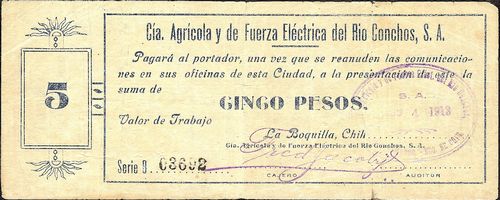
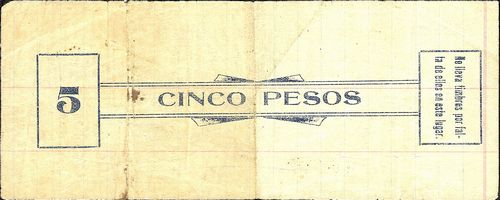
| series | from | to | total number |
total value |
||
| $5 | D | includes number 03692 |
The Compañía Agricola de Luz y Fuerza del Río Conchos, S.A. gained its concession, including the establishment of a tienda de raya, on 7 December 1906. On 23 October 1909 it was granted a concession to build a railway from Ciudad Camargo to La Boquilla. It built the dam at La Boquilla from 1910 to 1916, during the height of the revolution.
We know of a valor de trabajo for five pesos, dated 4 August 1913.
| Fred Jacoby |  |
Guanacevi
Although geographically in Durango, Guanaceví had close ties with Parral and various issues from there circulated and were the subject of pronouncement in Parral. These are dealt with in the Durango and consists of the Concurso México Consolidated Mining and Smelting Company, E. F. Knotts, and the Jefatura Municipal.

